This Recoleta neighbourhood guide will help you explore Buenos Aires’ most elegant district, filled with Belle Époque buildings!
Elegant, historic, and effortlessly charming are just a few words to describe Recoleta. This neighbourhood is home to historic mansions, leafy plazas and old-world cafes, and it is the reason why Buenos Aires is often called “the Paris of South America”!
While I have stayed in a lot of different Buenos Aires neighbourhoods over the years, Recoleta is my personal favourite and it’s the one I recommend to first-time visitors.
There’s something magical about walking down grand avenues lined with cream coloured buildings that transport you back to another era, while still being within walking distance of so many tourist attractions. It’s the perfect introduction to the city!
In this Recoleta neighbourhood guide, I’ll share the top things to do, places to eat, and best hotels to stay in, so you can experience this neighbourhood like a local and make the most of your time in Buenos Aires, Argentina.
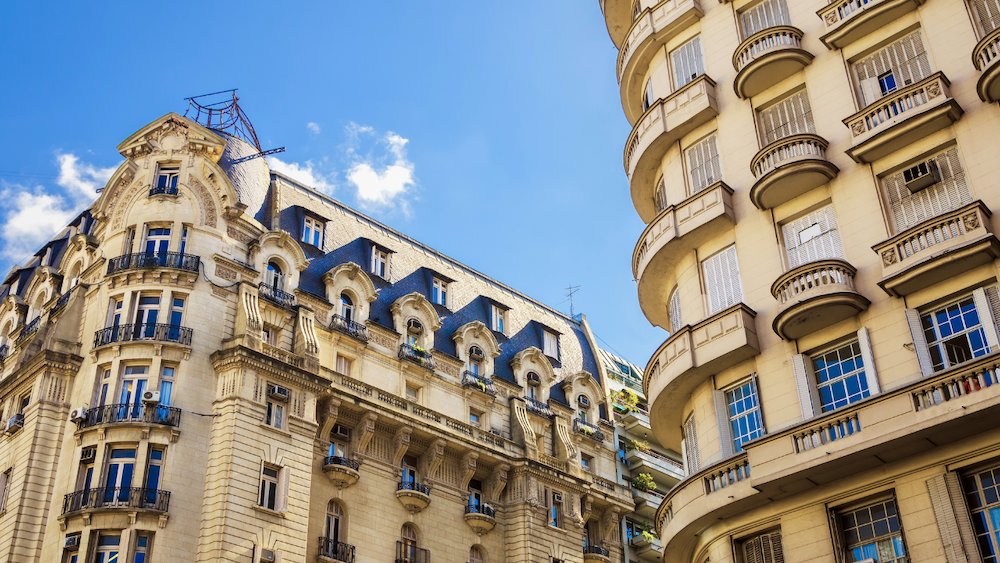
Things to Do in Recoleta
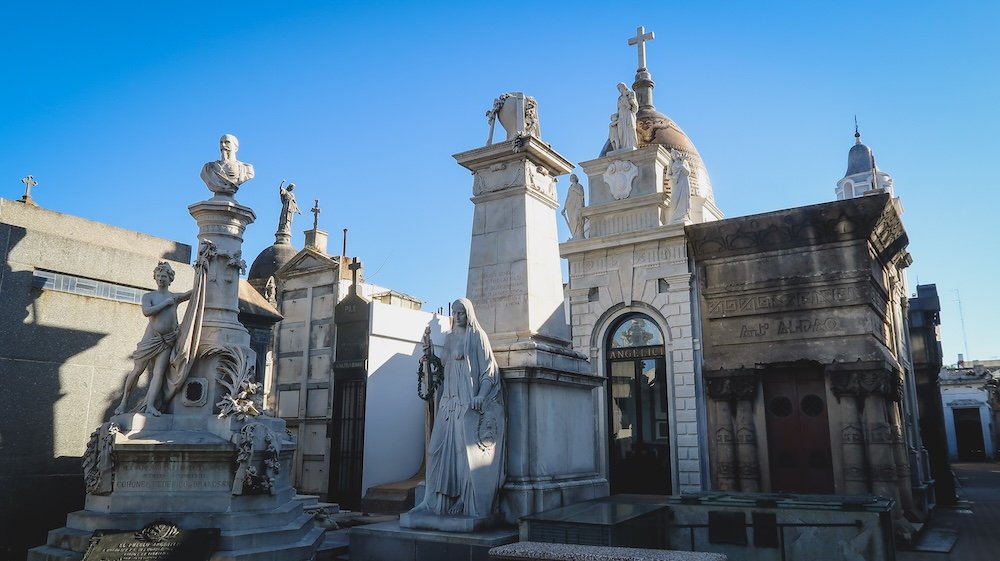
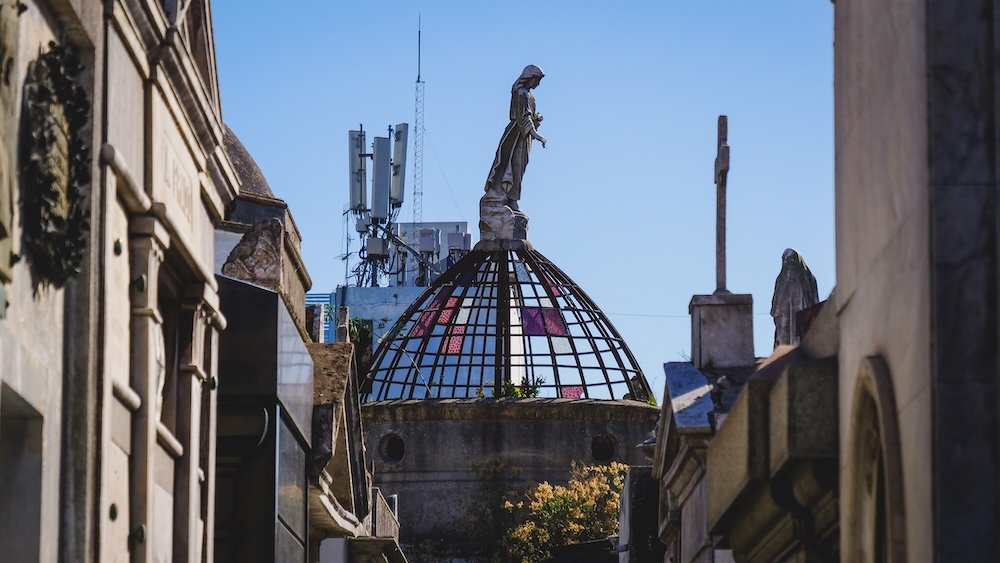
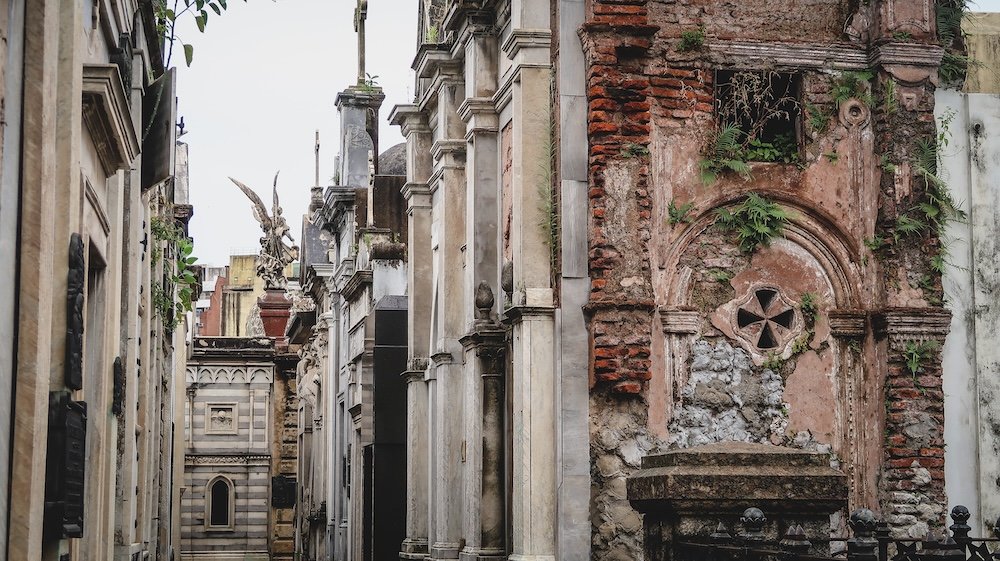
Recoleta Cemetery
A cemetery may seem like a bit of a morbid attraction, but Recoleta Cemetery is one of Buenos Aires’ most iconic landmarks!
Established in 1822 on the grounds of a former convent, this became the city’s first public cemetery and soon evolved into the final resting place of Argentina’s elite. It is home to many notable figures, including several presidents, military leaders, Nobel Prize winners, athletes, and members of the city’s most powerful families.
Recoleta Cemetery feels like a mini city, complete with cobblestone paths and a maze of more than 6,400 mausoleums and tombs, many designed by leading architects and sculptors of the 19th and early 20th centuries. Most visitors make a beeline for the black marble tomb of Eva Perón, better known as Evita.
I have visited Recoleta Cemetery many times over the years, and one of the big draws was the stray cats who lived there! Well, today, you’ll be hard-pressed to find these felines, but that’s because they have been adopted, and those who remain have been spayed and neutered. So while I miss spotting the cats napping in the mausoleums, it’s actually good news.
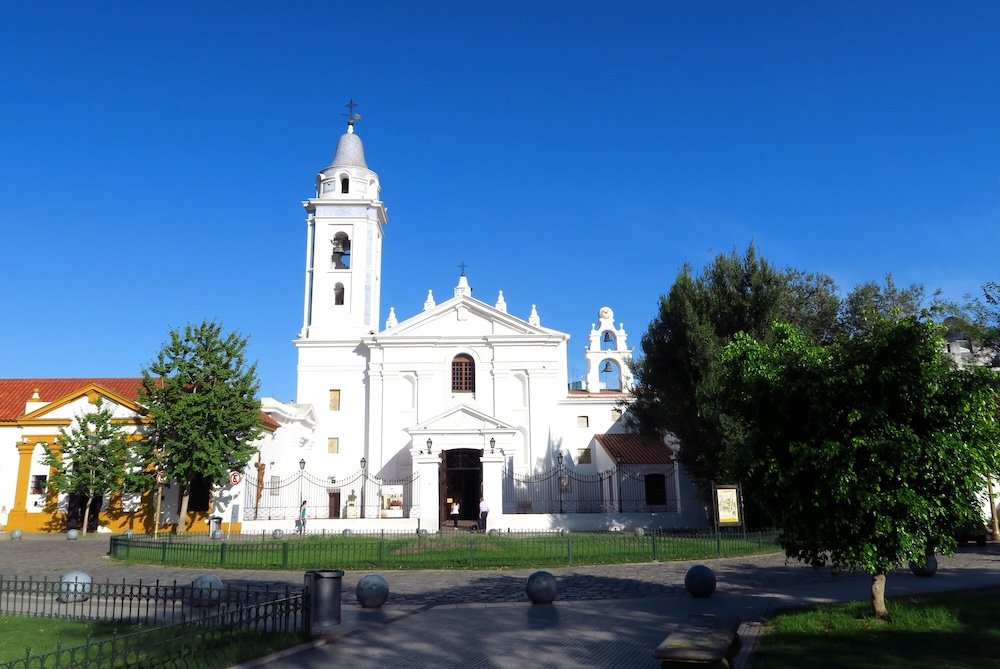
Basílica Nuestra Señora del Pilar
Standing beside Recoleta Cemetery, you’ll find the Basílica Nuestra Señora del Pilar, one of Buenos Aires’ oldest churches.
Completed in 1732, it was originally part of a Franciscan monastery and is a rare surviving example of colonial baroque architecture in the city. Its white façade and understated interior contrast with the grandeur of the surrounding Belle Époque buildings.
Inside, the basilica you’ll find altarpieces, religious paintings, and ornate silverwork, offering a glimpse into the city’s early colonial history and devotion.
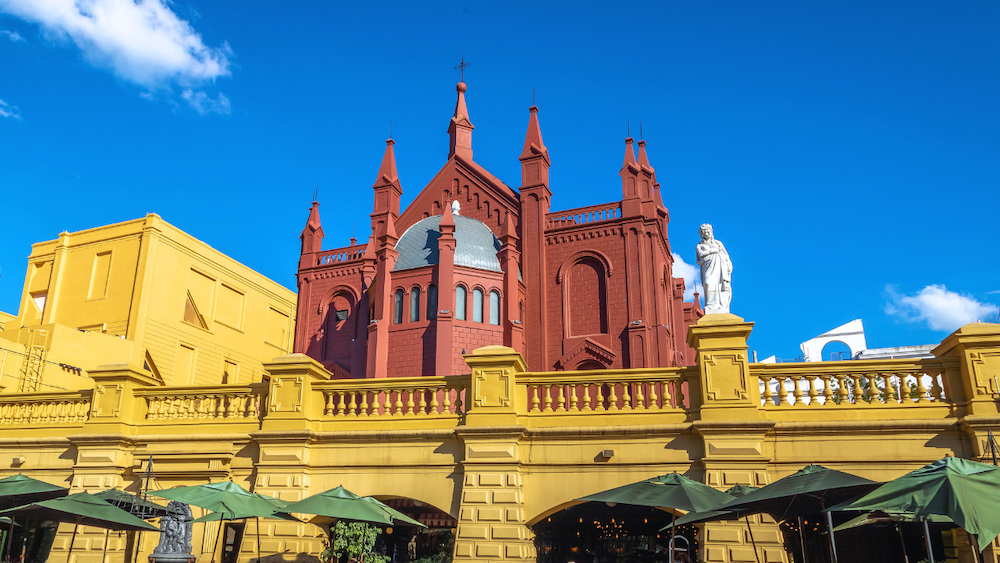
Centro Cultural Recoleta
Housed in a former 18th-century convent, the Centro Cultural Recoleta is one of Buenos Aires’ most vibrant creative hubs, blending historic architecture with contemporary culture.
Located right next to Recoleta Cemetery, this space features a constantly changing lineup of exhibitions, performances and workshops that showcase cutting-edge Argentine and international art.
The building itself retains beautiful colonial elements, including courtyards and cloisters, which now serve as lively gathering spaces.
Fun fact about this building: it is a canvas in and of itself, and it is constantly getting repainted! Over the years, I’ve seen it range from a traditional terracotta colour to one covered in bold shapes and patterns.
Feria de Recoleta
The Feria de Recoleta, or Recoleta Market, is a lively weekend artisan fair that takes place in Plaza Francia, right beside Recoleta Cemetery and the Centro Cultural Recoleta.
The fair is held every Saturday, Sunday, and public holiday, transforming the park into a bustling open-air market filled with hundreds of stalls run by local artisans.
Here you’ll find a wide range of artisanal goods that make great souvenirs, including leather accessories, silver jewelry, mate gourds, ceramics, textiles, original artwork, and quirky souvenirs that make for meaningful keepsakes.
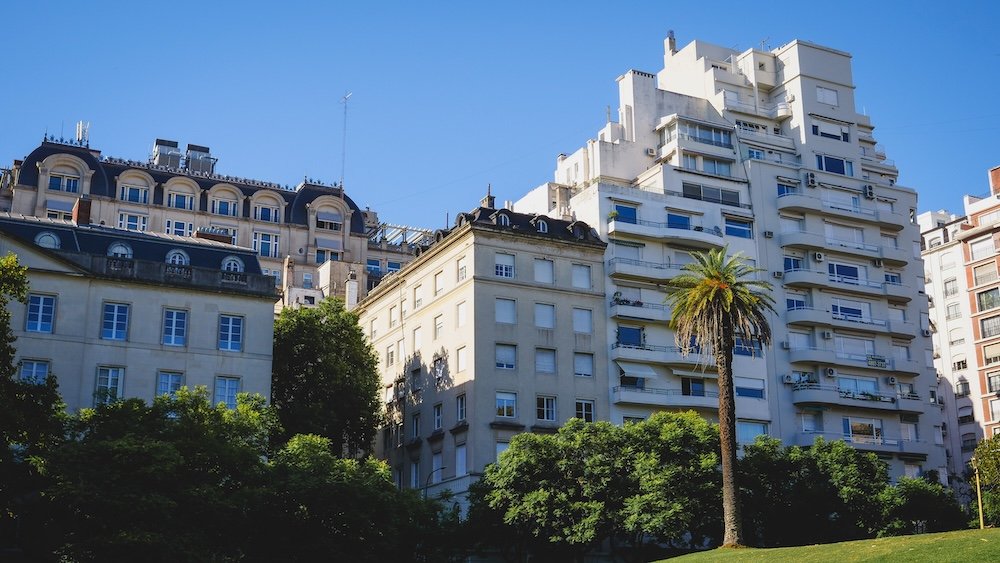
Walk the Plazas
Recoleta is a neighbourhood of parks and plazas, and the best part is that many of them are interconnected. So if you’re somebody who enjoys a morning jog or stroll, you’ll have plenty of paths to choose from.
Some of my favourites are Parque Vicente Lopez y Planes with its huge gomero tree. I always enjoy seeing the dog walkers here who bring the dogs to play.
Meanwhile, Plaza San Martín de Tours has a nice hill, and it’s a beautiful spot to lounge and admire the surrounding architecture.
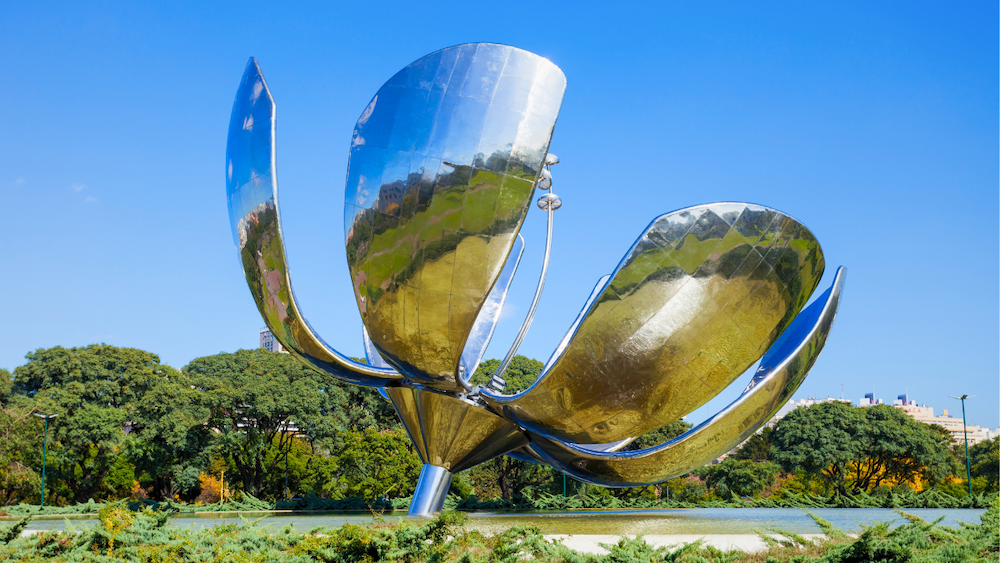
Floralis Generica
Floralis Genérica is one of Buenos Aires’ most striking modern landmarks! Located in Plaza de las Naciones Unidas, it is a massive steel and aluminum flower sculpture that opens and closes.
Designed by Argentine architect Eduardo Catalano and inaugurated in 2002, the 20-meter-tall flower was originally engineered to open at dawn and close at night. This daily movement made it a living, breathing artwork that mirrored the rhythms of the city.
Unfortunately, the sculpture has been affected by extreme weather over the years. First, a powerful storm in 2010 damaged the mechanism that controlled the petals, leaving the flower permanently open for several years until 2015.
Then, strong winds hit the sculpture again in 2023, and two of the petals bent and fell during the storm. So, it’s not quite what it used to be, but it’s still an important attraction in Recoleta.
Arandu Talabarteria
Arandú Talabartería is a beautiful store that specializes in traditional Argentine products that represent the countryside. They have a handful of stores across the city, including one in the neighbourhood of Recoleta.
Here you can find leather goods, riding boots, silver jewellery, polo shirts, gaucho clothing, and so much more.
The space has been carefully curated, and it almost feels like a museum, so it’s worth a peek if you’re in the area.
Patio Bullrich
Once an upscale auction house for thoroughbred cattle, Patio Bullrich is now one of Buenos Aires’ most elegant shopping centers.
Located at the edge of Recoleta, this beautifully restored 19th-century building features ornate ironwork, marble details, and a soaring glass roof, giving the mall a touch of European flair.
Inside, you’ll find a curated selection of high-end boutiques, including both international designer labels and prestigious Argentine brands.
While it’s not the largest mall in the city, it is a pleasant place to browse, enjoy a coffee, or escape a rainy afternoon in Buenos Aires.
It’s especially popular with visitors looking for leather goods, fashion, and luxury accessories.
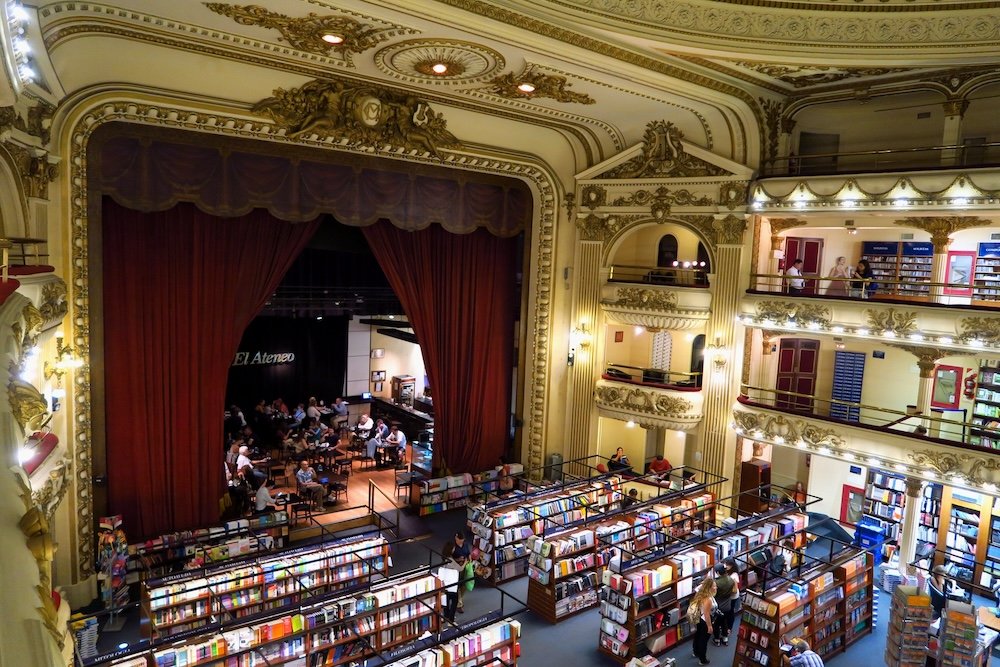
El Ateneo Grand Splendid
Housed in a former grand theatre, El Ateneo Grand Splendid is one of the most breathtaking bookstores in the world and an absolute must-visit in Recoleta.
Built in 1919 as the Teatro Grand Splendid, the building originally hosted tango performances, live shows, and even early radio broadcasts before being transformed into a bookstore in 2000.
Today, its ornate frescoed ceiling, gilded balconies, and red stage curtains create a dramatic backdrop for rows of bookshelves and cozy reading nooks.
Visitors can browse literature in Spanish and other languages, flip through art books under the theatre’s domed ceiling, or relax with a coffee at the café set on the former stage.
Whether you’re a book lover or simply appreciate stunning architecture, El Ateneo Grand Splendid deserves a spot on your Buenos Aires itinerary!
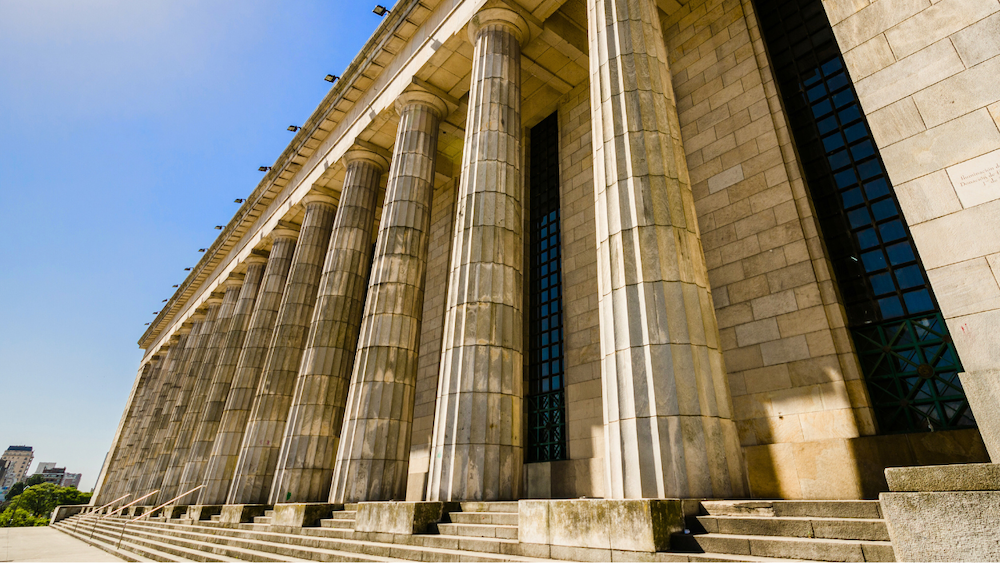
Facultad de Derecho
The Facultad de Derecho, or the Law Faculty of the University of Buenos Aires, is one of the neighbourhood’s most imposing buildings.
Located along Avenida Figueroa Alcorta at the edge of Recoleta, this Neo-Classical building was inaugurated in 1949. It is instantly recognizable by its façade featuring a row of massive stone columns that give it the appearance of a Greco-Roman temple.
This striking structure houses one of Argentina’s most prestigious law schools and remains an active university building, bustling with students during the academic year.
Visitors can admire the architecture from the outside and stroll up its wide steps for a panoramic view of the surrounding area.
With the Floralis Genérica just across the street, it’s a natural stop on any Recoleta walking route.
TIP: The Law Faculty is a great spot to see the jacarandas in bloom if you’re visiting Buenos Aires in the springtime!
Museo Nacional de Bellas Artes
The Museo Nacional de Bellas Artes (MNBA) is Argentina’s premier fine arts museum and one of the cultural crown jewels of Buenos Aires.
Located in Recoleta, just steps from Plaza Francia, the museum occupies a former water pumping station that was converted into an exhibition space in 1933.
Its collection spans European masters, Argentine artists, and Latin American modernists. You can admire works by Goya, Rembrandt, Monet, Rodin, and Degas, alongside an extensive collection of Argentine paintings and sculptures that trace the country’s artistic evolution from the 19th century to today.
The museum’s permanent collection is free to visit, making it an accessible cultural experience for travellers, while rotating temporary exhibitions bring fresh perspectives to the space.
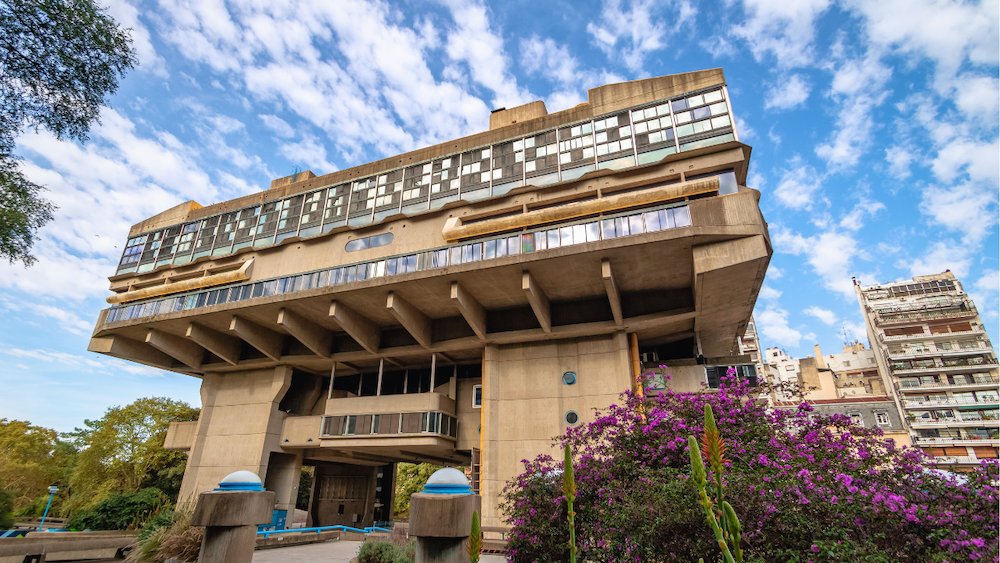
Biblioteca Nacional Mariano Moreno
The Biblioteca Nacional Mariano Moreno is Argentina’s national library and a fascinating architectural landmark in Recoleta.
Completed in 1992, it’s a striking example of Brutalist architecture, with a massive concrete structure perched on stilts above open terraces and gardens. It’s a very bold contrast to the surrounding Belle Époque buildings you see in Recoleta!
Named after Mariano Moreno, a key figure in Argentina’s independence movement, the library holds millions of books, manuscripts, maps, and historical documents, making it one of the most important literary institutions in Latin America.
While it primarily serves as a research library, visitors are welcome to explore the public areas, including the lobby, reading rooms, and occasional temporary exhibitions.
The building’s panoramic terrace also offers excellent views of the city and Río de la Plata, and architecture enthusiasts will especially enjoy its distinctive design.
This isn’t your typical Recoleta tourist attraction, but it’s a worthwhile stop if you want to discover some of Buenos Aires’ lesser-known sights.
Palais de Glace
Palais de Glace, also known as Palacio Nacional de las Artes, is another Belle Époque landmark in Recoleta.
It was originally conceived as an elegant ice-skating rink and social club in the early 20th century. It then transformed into a dance hall where tango orchestras performed, before being repurposed into an art gallery.
The circular central hall, topped by a domed roof and skylight, now hosts rotating exhibitions.
Mansions and Embassies
One of the best ways to appreciate Recoleta’s timeless elegance is by setting out on a self-guided walking tour through its tree-lined streets and grand avenues.
Start along Avenida Alvear, often compared to Paris’s Avenue Foch, where a series of Belle Époque mansions built in the late 19th and early 20th centuries showcase the wealth and ambition of Argentina’s Golden Age.
Many of these opulent residences were designed by French architects and feature wrought-iron balconies, ornate cornices, mansard roofs, and intricate stonework that echo the styles of Paris.
Today, several of these historic buildings house embassies, cultural institutes, and luxury hotels (more on that later!).
Where to Eat in Recoleta
La Biela
My go-to cafe whenever I’m in the Recoleta neighbourhood is La Biela. This is one of Recoleta’s most famous cafés and a designated bar notable.
It is conveniently located on Avenida Quintana right across from the Basílica del Pilar and Recoleta Cemetery.
Its history dates back to the mid-19th century, when it began as a simple sidewalk bar before evolving into a meeting spot for pilots and later car enthusiasts.
Over the years, La Biela became a favourite haunt of intellectuals, writers, and artists, including Jorge Luis Borges and Adolfo Bioy Casares, whose table remains permanently set in their honour.
Inside, La Biela exudes old-world charm with wood panelling, vintage racing memorabilia, and black-and-white photographs, while its shaded terrace beneath a century-old rubber tree is perfect for people-watching.
I like to stop in for merienda or tea time. If you order the Recoleta, you’ll get tea with pastries and a toasted ham and cheese sandwich, which is pretty classic.
Address: Avenida Presidente Manuel Quintana 596
La Rambla
Café La Rambla is a beautiful corner café that has retained its authentic porteño charm since opening in 1938.
Small, unpretentious, and full of character, it’s one of those cafés where time seems to slow down. It’s a place favoured by locals for their daily coffee, medialunas, and quiet conversations.
I first came across La Rambla on a rainy morning, looking for breakfast. The cafe won me over with its desayuno clásico featuring coffee with milk, two medialunas and a glass of fresh-squeezed orange juice.
Address: Posadas 1602
El Sanjuanino
El Sanjuanino is known to serve some of the best empanadas in Buenos Aires!
The empanadas sanjuaninas (from the province of San Juan) are their specialty. These empanadas are known for being juicy and flavorful. I would suggest trying the fritas (fried), which are infinitely superior to the horneadas (baked).
Aside from empanadas, El Sanjuanino’s menu also features regional dishes from northern Argentina, which include staples like locro, humitas, and tamales.
Now, let me warn you, El Sanjuanino is a local institution in Recoleta. Every time I walk past it, every table is completely packed! I would suggest arriving just before they open, so you can snag a spot.
Address: Posadas 1515
L’Orangerie at Alvear Palace Hotel
If like me, your budget doesn’t stretch far enough to spend the night at Alvear Palace Hotel, another way to see the property is by having afternoon tea!
Tea is served in the winter garden, and it’s an elegant affair with a spread that includes warm scones with marmalades, a tiered selection of finger sandwiches and pastries.
They offer a wide selection of teas, among them the hotel’s signature Alvear Blend, a black tea infused with almonds, citrus, and rose petals! It’s as exquisite as it sounds.
I took my parents for afternoon tea here during one of their visits, and it was one of the highlights of our adventures across the neighbourhood of Recoleta.
Address: Avenida Alvear 1891
Rapa Nui
Rapa Nui is an ice cream chain with branches all over Buenos Aires, however, the one in Recoleta is the one that I frequent the most. This location is set in a Belle Epoque building with high ceilings, lots of natural light and a small inner terrace.
If you have a sweet tooth, you’ll love Rapa Nui because you can enjoy a mix of artisanal chocolates, helados (ice cream), and confections.
My husband loves anything with dulce de leche, whereas I tend to go for the fruit and cream combinations with forest berries.
Buenos Aires has a serious ice cream culture, so I would highly recommend making time to visit an heladería or two!
Address: Uruguay 1284
Aramburú
If fine dining is more your scene, you’ll want to visit Aramburu. This restaurant is helmed by chef Gonzalo Aramburu, and it is one of Recoleta’s most celebrated fine-dining establishments.
This is not an experience that can be booked by walking in off the street; reservations need to be made in advance.
What sets Aramburu apart is its 18-course meal featuring a seasonally evolving tasting menu that emphasizes local ingredients and playful textures. You can choose to add on a wine-pairing option to enhance the experience.
Aramburu was the first restaurant in Argentina to earn two Michelin stars, and it is also a Relais & Châteaux property. It’s one of the best restaurants in Recoleta if you’re looking for something sophisticated, intimate and refined.
Address: Pasaje del Correo, Vicente López 1661
Where to Stay in Recoleta
Alvear Palace Hotel
If it’s luxury you are after, look no further than the Alvear Palace Hotel. This is a classic symbol of Recoleta opulence, and the property features Louis XIV/XV interiors, marble finishes, lush fabrics, and a long tradition of ultra-refined service.
View rates at Alvear Palace Hotel.
LOI Suites Recoleta
Perched in the heart of Recoleta steps from the cemetery, LOI Suites Recoleta blends elegance and comfort in a boutique hotel atmosphere. The style is elegant with French-style windows, lots of natural light and cozy interiors. Guests can unwind in the hotel’s indoor pool, spa facilities, and the winter garden lounge that feels like a little oasis in the city.
View rates at LOI Suites Recoleta.
A Hotel
Believe it or not, it is possible to find budget-friendly accommodations in Recoleta! At A Hotel, you’ll get tastefully decorated, spacious rooms with private bathrooms. And because this is an art hotel, the rooms also feature original works of art by Argentine painters.
Recoleta Neighbourhood Map
More Buenos Aires Neighbourhoods
Now that you’ve read this Recoleta neighbourhood guide, you can decide if it’s the right place for you. If you’re looking for a slightly different vibe, here are a few other Buenos Aires neighbourhoods to consider:
Palermo – Trendy, sprawling, and green, Palermo is the city’s creative heart with hip cafés, boutiques, nightlife, and parks. Best for foodies, digital nomads, and travellers who love a vibrant, youthful vibe.
San Telmo – Buenos Aires’ oldest neighbourhood is filled with cobblestone streets, antique shops, and tango culture. Perfect for history buffs, art lovers, and those who enjoy a bohemian, romantic atmosphere. I find some areas can be a bit loud at night since there’s quite a bit of nightlife.
Puerto Madero – Sleek, modern, and waterfront, this area blends luxury living with scenic boardwalks and upscale dining. Ideal for travellers who love contemporary architecture, comfort, and leisurely strolls by the docks.
Retiro – A blend of elegance and transit hub energy, Retiro features grand architecture, leafy plazas, and proximity to major attractions. Great for those who want central access with a dash of old-world charm.
Monserrat / Microcentro – This neighbourhood is the political and historic core of Buenos Aires, packed with landmarks like Plaza de Mayo and Casa Rosada. Perfect for visitors who want to be in the middle of the action, especially during the day. Some parts are a bit more gritty than others.
La Boca – Colourful, gritty, and full of character, La Boca is home to Caminito street, fútbol culture, tango and working-class history. This neighbourhood is better suited for daytime exploring, and I personally would not stay overnight here.
Chacarita – A rising star with a laid-back, local feel, known for its large cemetery, craft breweries, and creative scene. Great for travellers seeking a more authentic, untouristy slice of city life.
Villa Crespo – Palermo’s quieter, cooler neighbour, blending old-school charm with emerging restaurants and indie shops. Ideal for those who like staying local and discovering hidden gems off the main tourist trail.
GROUP TOURS – If you’d rather join a group tour to travel in Argentina, check out Gadventures.
CAR RENTAL – To explore Argentina beyond the cities, the best way to do so is by renting a car. Discover Cars offers rentals across the country.
BUS TICKETS – Bus travel is a great way to see Argentina. BusBud offers numerous routes.
TRAVEL INSURANCE – Don’t leave on your trip without booking travel insurance. You can get a quote on SafetyWing.
HOTELS – Booking.com offers accommodations to suit all budgets and travel styles.
TOURS – For a variety of tours and activities, have a look at Viator.
